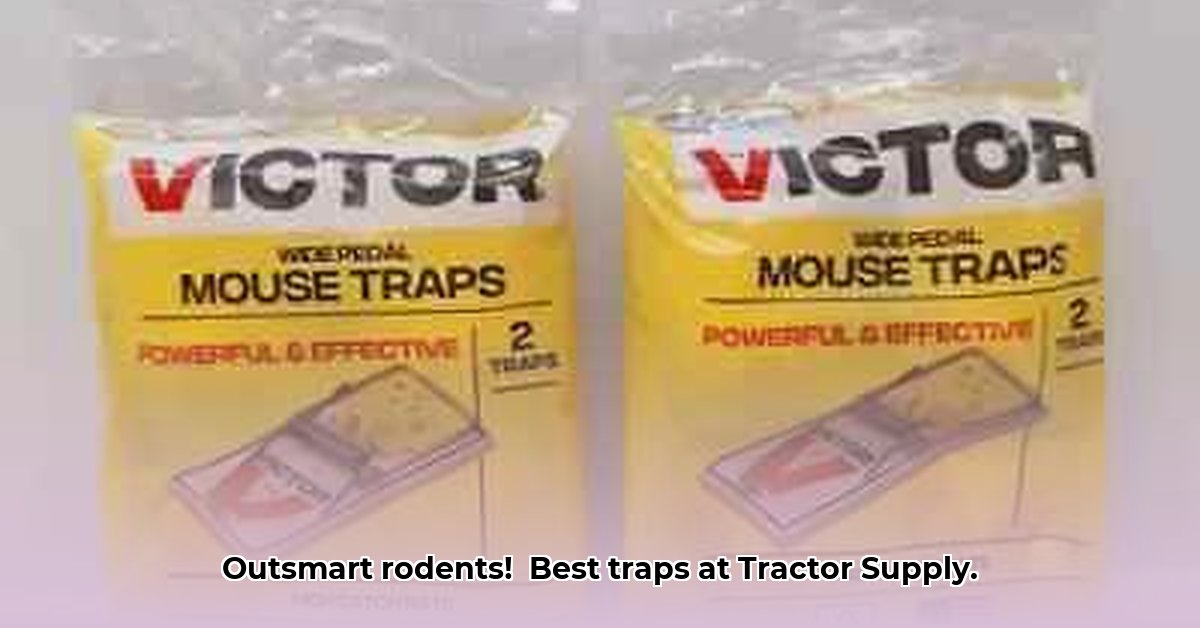
Dealing with rodents in agriculture presents a significant challenge, impacting crop yields and farm sustainability. However, effective rodent control doesn't necessitate harsh chemicals. This guide details humane and environmentally sound methods for managing rodent populations, focusing on strategies compatible with sustainable farming practices and readily available resources from Tractor Supply. For even more great deals on farm supplies, check out Tractor Supply sales.
Understanding the Scope of the Rodent Problem
Rodent infestations cause substantial economic losses for farmers. Studies indicate yield reductions of 10-20% or more, translating to increased costs for resources like water and fertilizer [1]. This negatively affects farm profitability and environmental sustainability. Effective control strategies are crucial not only for immediate yield protection but also for the long-term health of the farm ecosystem.
The Tractor Supply Advantage: A Range of Rodent Control Options
Tractor Supply provides a variety of rodent control tools catering to diverse farming philosophies. The choice of the most appropriate method depends on individual preferences regarding cost, effectiveness, and ethical considerations.
- Snap Traps: Inexpensive and readily available, these traps offer a quick kill but are considered inhumane by many. Disposal of carcasses is also necessary, adding to the environmental impact.
- Live Traps: These reusable traps allow for humane capture and relocation, a more environmentally friendly approach. While the initial investment is higher, the long-term cost is often lower. Various sizes are typically available at most Tractor Supply locations.
- Electronic Traps: Utilizing a high-voltage shock, these traps provide a relatively quick kill and are often reusable, but proper disposal of the electric components is crucial to minimizing environmental impact. The availability of these traps may vary depending on the store.
- Poison Bait Stations: Rodenticides present a controversial method. While effective for population control, they pose environmental risks and potential dangers to domestic animals and non-target species. Strict adherence to regulations and best practices for handling and disposal is mandatory. Thorough research and understanding of local regulations are crucial before using this option.
Do you find yourself questioning whether the cost of humane traps outweighs the long-term benefits? The initial investment in live traps often proves more economical over time compared to continuously purchasing snap traps.
Choosing the Right Trap for Your Sustainable Farm
The following table summarizes the advantages and disadvantages of each trap type, helping you choose the most appropriate solution for your specific needs and sustainable farming goals.
| Trap Type | Pros | Cons |
|---|---|---|
| Snap Traps | Inexpensive, readily available, effective, quick kill | Inhumane, requires carcass disposal, not environmentally friendly |
| Live Traps | Humane, reusable, environmentally friendly, allows relocation | Higher initial cost, requires time and effort for relocation |
| Electronic Traps | Often considered humane (quick kill), reusable | Initial cost can be higher, potential environmental concerns with disposal |
| Poison Bait Stations | Effective for population control, some long-lasting effects | Environmental risks, potential danger to pets and non-target animals |
Developing a Comprehensive Rodent Control Plan
A sustainable rodent control strategy goes beyond simply purchasing traps. It requires a multi-faceted approach integrating preventative measures, humane trapping methods, and ongoing monitoring.
Thorough Scouting: Identify rodent activity through droppings, gnaw marks, and burrow identification. This prioritizes efforts where they are most needed.
Trap Selection: Choose traps aligning with ethical preferences and budget constraints. Consider the higher long-term cost-effectiveness of humane options.
Strategic Placement: Position traps along rodent pathways, near food sources, or at entry points. Utilizing multiple traps increases the likelihood of successful capture.
Consistent Monitoring: Regularly check traps (ideally daily) for captured rodents. Proper disposal methods must comply with local regulations.
Preventative Measures: Minimize attractants by properly storing food, cleaning up spills, and sealing entry points to buildings. This proactive approach reduces rodent attraction to your farm.
Did you know that a simple sanitation strategy can drastically reduce rodent attraction? Regular cleaning and the removal of food sources are highly effective preventative measures.
Integrated Pest Management (IPM): A Holistic Approach
Integrated Pest Management (IPM) emphasizes preventing infestations. Applying IPM strategies alongside trapping significantly enhances the efficacy of your rodent control program.
- Habitat Modification: Maintain clean fields, remove potential nesting sites, and minimize debris that could serve as shelter.
- Biological Control: Consider introducing natural predators (such as owls or snakes) where appropriate, but only under expert guidance to avoid ecosystem disruption.
- Sanitation: Strict sanitation practices are paramount, minimizing food and shelter available to rodents.
By combining effective trapping methods with a comprehensive IPM approach, you can effectively manage rodent populations while upholding ethical and environmental standards. Continued vigilance and adaptation are keys to long-term success in sustainable rodent control.
[1]: (Insert citation here referencing a relevant study on rodent damage and economic impact in agriculture)